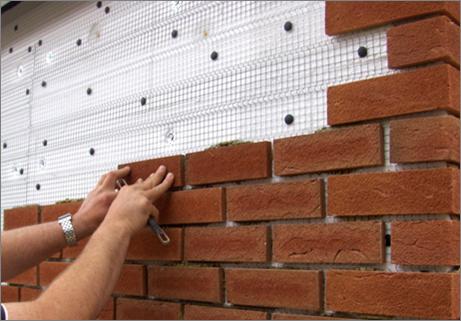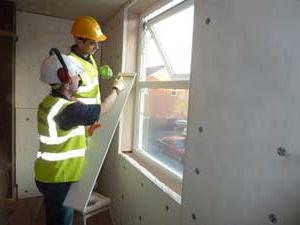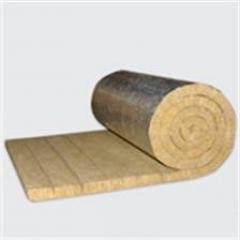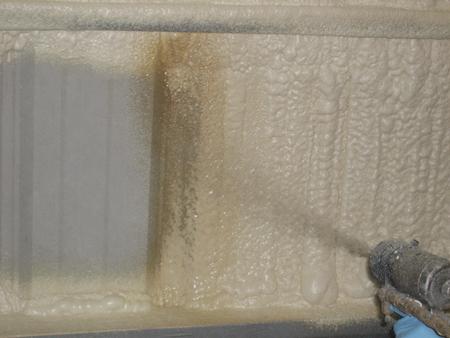Internal thermal insulation of an apartment or private house is an important and complex undertaking. There are many reasons for this: high tariffs for gas and electricity, low level of insulation of premises (this is especially true for old houses and apartments). And there are cases when the installation of the thermal insulation system is possible only from the inside of the building. How to insulate a wall from the inside? The answer to this question cannot be unambiguous. In order to carry out high-quality thermal insulation, you need to be guided by many criteria: characteristics of the structure of the room, climatic conditions, operational features of the house and the choice of a suitable material.
Why carry out internal insulation?
Internal wall insulation is a great option for budget conscious people. Special materials retain heat inside the room, in addition to increasing the heat-insulating properties, eliminating the possibility of cold air entering from the street and reducing the noise level.
Average statistical data show that with the help of heat-insulating materials, electricity and gas savings are 45%. This means that utility bills are halved.
Before insulating the wall in the apartment from the inside, you need to carry out preparatory work. First, you need to figure out in which cases external thermal insulation is impossible:
- If your apartment is located in a multi-storey building that has the status of an architectural structure or its facade is decorated with decorative elements.
- In some cases, the authorities prohibit the external insulation of the facade of high-rise buildings.
- The apartment is located at the place where the expansion joint passes. It is an important structural element that ensures the structural resilience of a multi-storey building.
- There is an elevator shaft behind the partition of the apartment.
- The facade of an apartment or a private house is decorated with expensive decorative elements, and therefore the owner has no desire to cover them with insulation materials.
It should also be remembered that some insulation materials make the room 10-20% smaller. However, the appearance remains unchanged, and therefore it will not affect the design in any way.
Advantages of internal thermal insulation
How to insulate the walls of a house and what is the benefit from this? This technique has more advantages than outdoor.
- The level of isolation rises. For example, in winter, the building will keep warm. But in the summer season, thanks to the insulation elements of the structure, the night coolness will be kept all day long.
- Affordable cost. The modern construction market offers a huge range of inexpensive and high-quality insulation materials. So there will be no problems with the choice.
- The procedure is simple. Indeed, if you understand everything and carefully study the installation instructions, then do-it-yourself wall insulation is a simple task. You don't need to be a professional builder and have a set of special tools for this.
- Thermal insulation can be carried out in any season. Unlike external insulation, internal insulation is possible both in winter and summer. Snow, rain, wind - it doesn't matter. Regardless of the temperature outside, work continues. In addition, this eliminates the danger for apartment owners in high-rise buildings.
Material selection by criteria
Before thinking about how to properly insulate the walls, you need to carry out preparatory measures, the list of which includes the selection of suitable material. What parameters should be used to choose it?
- Fire resistance. The risk of fire must be minimal and the material must be resistant to high temperatures.
- Low thermal conductivity. The technology of wall insulation dictates its own rules, in accordance with it, the building material must have a low percentage of thermal conductivity, because only in this case the heat will be retained inside the building. Otherwise, the walls will allow both warm and cold air to pass through.
- Environmental friendliness. Thermal insulation elements must be made of natural materials. If they contain toxic substances or impurities, then this is a real threat not only to human health, but also to everyone around.
- Wear resistance and long service life. If the insulation is really of high quality, then its properties will be preserved even under the most unfavorable environmental influences. There is no need to fall for such a trick as a low price, because, most likely, such material is of dubious quality. If the product has a certificate, it is important to check it to make sure it is environmentally friendly and durable.
- Moisture resistance. A water resistance test should be carried out. Condensation is the # 1 enemy for modern heaters. Therefore, you need to choose a material that has a high degree of resistance to moisture. Only in this case will it retain its best qualities (strength, shape, thermal insulation, low thermal conductivity, etc.).
Popular heaters
The modern building materials market offers a wide selection. And therefore, the question of how to insulate the walls does not cause difficulties. The main thing is to choose the insulation that is right for you: natural, synthetic, in rolls or sheets.
Most popular heat insulators:
- Penoplex. This novelty is essentially foamed plastic. This material has similar characteristics with foam, the only difference is that the foam is denser and has a high level of thermal insulation. This material is highly moisture resistant, which excludes the appearance of condensation on the walls of the room. In addition, it is environmentally friendly and resistant to high temperatures. It contains flame retardants that prevent it from igniting even at temperatures of +400 ° C.
- Drywall. This material also has many advantages. First, it is easy to handle and install. It is quite moisture resistant, strong and durable. In addition, it has good thermal insulation performance. Drywall looks neat on the walls, but is inexpensive.
- Polyurethane foam. This liquid building material guarantees a high level of thermal insulation. It penetrates deep into the wall surface and creates a strong and reliable, but at the same time thin (about 5 mm) layer, which retains heat inside the building. The advantage of this material is that it absolutely does not cut off the space of the room. This option is especially suitable for small rooms where you need to save every square meter. Polyurethane foam completely eliminates condensation. Moreover, it is durable and wear-resistant.
Such materials for wall insulation as polystyrene, mineral wool and warm plaster are also quite in demand.

Stone insulation
You can try different methods, for example, the old and reliable old-fashioned way - wall insulation with your own material. If the walls of a private house or apartment are stone, then you can use stone, brick and plaster. How to insulate a wall from the inside with a stone?
To do this, you need to overlay the entire inner perimeter of the room with natural or synthetic (finishing) stone. Masonry must be reinforced against the old wall using metal meshes or rods. This will make the wall more solid.
An important nuance - the old surface must be attached to the new one using concrete mix or mounting mortar.
Advantages:
- Cost savings during wall preparation. No need to spend money on preparatory work, you just need to thoroughly clean the old wall. If necessary, you can putty the cracks or just level the base a little.
- Moisture resistance. The problem of condensation is eliminated, since the natural material allows the room to breathe.
- Improving the technical properties of the wall surface. The wall becomes stronger, more wear-resistant and durable. In addition, the thermal insulation qualities are at a high level.
Disadvantages:
- Space is cut off. Since the material is quite thick, square meters are simply lost, and therefore this option is not suitable for small rooms.
- The load on the supporting structure of the building increases. Heavy material creates additional stress on the floor, which over time can bend or even break.
- Construction skills. In order to carry out such a procedure, you need to have experience in work related to the construction of structures from stones. Otherwise, this task is impossible.
How to insulate a brick wall? In the same way, only using bricks instead of stone.
Of course, this method is very reliable, but, on the other hand, the process is incredibly time consuming and requires some knowledge and practice. In addition, stone and brick will cost you more than other heat insulators. That is why this method is not so popular.

Warming with wooden logs
If the walls of your country house are made of wood, then it would be logical to use native material. Moreover, it is absolutely natural and has excellent technical characteristics. It is better to insulate wooden walls in a spacious room, since the beams are quite thick and voluminous. This technology is reliable, it was used many years ago and is still the privilege of wealthy people.
The inside of the wooden room must be covered with boards. You can attach the boards to the crate, but it depends on their thickness. You can insulate the surface with slag, sawdust or expanded clay.
Advantages:
- Cost savings during the preparation phase. If you choose this method of thermal insulation, then the cost of preparatory work will be minimal.
- Moisture resistance. The design turns out to be quite dense, which is why the manifestation of condensation on the walls is excluded. With this property, wood compares favorably with modern heat insulators.
Disadvantages:
- Risk of fire. As everyone knows, wood is highly flammable, and therefore there is a certain risk.
- Space is cut off. The boards are thick enough, and therefore part of the space will simply be lost.
Thermal insulation of wooden walls in this way has many more advantages. The tree does not contain toxic substances, retains heat well, the walls breathe freely. In addition, this material improves the design, the room looks noble and at the same time stylish and modern.
Drywall

It is better to insulate the wall in the apartment from the inside with such a building material as drywall.
Phased action:
- Preparation. For this stage, you will need drywall, foam or mineral wool, which are responsible for insulation, building profile or mounting rails made of wood, fasteners, self-adhesive, vapor-proof membrane and antifungal fluid. You cannot do without a drill, puncher, hammer, scissors for metal and a level.
- Cleaning the walls. It is necessary to clean the surfaces, putty cracks, dry with a construction hair dryer.
- Application of a waterproofing mixture. This putty will protect the walls from moisture. Apply in 2 layers, the first vertically and the second horizontally.
- Preparation of a building plan. Using the markings, you can determine the location of the plumb bob. To do this, you need a plumb line.
- Installation of the skeleton. A metal frame is best suited, but before that, self-adhesive must be glued to the building profile. This will help keep you warm.
- Installation of a heat insulator. Fasten the rock wool or foam layer tightly to the base so that there are no gaps.
- Applying a vapor barrier film. You can use penofol, it will help save heat (about 98%).
- Installation of drywall sheets. Attach the heat insulator to the treated wall using dowels.
- Final work. At the joints, you need to apply a plaster mesh and apply several layers of putty. It is important to wait until the previous layer dries out.
As you can see, drywall insulation does not require special skills, but you need to be patient and strictly follow the instructions.
Penoplex

Thermal insulation of the room involves the use of thin foam boards (less than 50 mm). They have a rather useful quality - lightweight sheets do not overload the building structure. How to insulate a wall from the inside using foam plastic? This procedure involves performing the following operations:
- Preparatory stage. Cleaning surfaces from dust, dirt and fungus.
- Installation of a vapor barrier film. This means fixing special foil paper on the wall. You can fix it on the surface with a construction stapler with staples.
- Creation of a lattice structure. You need to create a crate using wooden slats that are installed on the wall. Small gaps should be left between the slats.
- Installation of a heat insulator. Wall insulation with foam is a responsible process. Insulation sheets are attached to the wall using self-tapping screws. And the joints must be closed with self-adhesive, which will exclude the appearance of a draft in the room.
- Additional vapor barrier. On top of the foam, you need to lay another layer of vapor barrier material.
- Finishing work. The final stage is finishing the walls with cladding material, after which they acquire a more aesthetic appearance. It is important to leave a small gap between the cladding layer and the heat insulator.
This type of heat insulators is a novelty in the construction market, it is quite simple to install, the main thing is to follow the rules. In addition, it has good thermal insulation properties, which explains its popularity.

Polyurethane foam
This material is used in various fields:
- Sandwich panel constructions for industrial and civil premises.
- With its help, a noise-insulating layer is created in the cabins of cars and airplanes.
- Polyurethane foam is used to insulate building facades, windows, doors and, of course, for internal thermal insulation. The process takes place by spraying the material onto the surface to be treated.
- With its help, engineering structures are isolated, which are designed to transport gaseous and liquid substances.
Thermal insulation with polyurethane foam is used in the automotive, electrical and other fields.
And, of course, it all starts with the preparatory stage. First, you need to prepare the surface of the wall, clean it and allow time to dry well. Metal surfaces must be cleaned of rust and thoroughly degreased with a special primer. If you are dealing with aluminum, then after cleaning it must be covered with a primer with good adhesion, it guarantees reliable bonding of the insulation to the wall.
In accordance with the technology of wall insulation with polyurethane foam, it is important to pay attention to the temperature indicators not only of the room, but also of the materials. If you want the heat insulator layer to show its best properties, the composition should have a temperature of 11 ° C to 27 ° C. It is also important to control the temperature of the building where the work will be carried out, it should be between 6 ° C and higher. If the room to be treated is cold, then the composition must be slightly warmed up before starting work (to the specified temperature).
Phased action:
- Preparation of the composition. This refers to the mixing of all components: reagents, fire-fighting and fixing components, isocyanate hardeners. Stir the hardener and the fixer separately, and filter if sediment occurs.
- Insulation application. Then, with a spray gun using a foam generator, the insulation is sprayed onto the wall surface.
- The final stage. If necessary, a spare layer of polyurethane foam can be applied. If the work is carried out independently, it is recommended to apply the insulation in several layers.
If you work with a heat insulator of this type, then you need to start spraying it from hard-to-reach surfaces: chimney, ventilation or pipeline, etc. But before starting work, you need to carefully cover all the joints. The thickness of the wall insulation is a very important factor, for example, the first layer should be no thicker than 15 mm. Then you need to let it freeze and then continue working.
The next two layers are applied on top of each other with a short break. It is best to carry out all stages of the work during the day. If this option does not suit you, then you need to carefully prepare the wall for spraying a new layer of insulation. The building has the best sound and heat insulation qualities, which is insulated with at least three layers of polyurethane foam.




